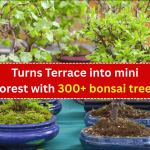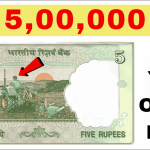
What started as a childhood passion for greenery has literally grown into a lush miniature forest on the terrace of Dr. Mukund Khatavkar’s house at Jed Galli in Shahapur, Belagavi. This remarkable transformation showcases how dedication, patience, and love for nature can create an extraordinary green oasis in an urban setting, inspiring countless others to embrace sustainable living and environmental conservation.
Dr. Khatavkar’s terrace garden is not just a collection of plants—it’s a living testament to the art of bonsai cultivation and urban gardening. With over 300 meticulously maintained bonsai trees representing diverse species, his rooftop has become a miniature ecosystem that challenges conventional notions of space constraints in city living.
The Journey from Passion to Paradise
Dr. Khatavkar’s journey began in childhood when he developed an innate fascination with plants and their intricate growth patterns. Unlike many who abandon childhood interests, he nurtured this passion throughout his medical career, gradually transforming his terrace into what can only be described as a botanical wonderland.
The transformation didn’t happen overnight. Over the years, Dr. Khatavkar has invested countless hours learning the delicate art of bonsai cultivation, understanding the specific needs of different species, and creating optimal growing conditions on his terrace. His dedication has resulted in a collection that rivals professional botanical gardens.
Creating the Perfect Environment
| Environmental Factor | Implementation Strategy | Benefits Achieved |
|---|---|---|
| Sunlight Management | Strategic placement and shade systems | Optimal light exposure for different species |
| Water Conservation | Drip irrigation and rainwater harvesting | Efficient water usage and sustainability |
| Wind Protection | Natural barriers using larger plants | Protection for delicate bonsai specimens |
| Temperature Control | Microclimate creation through plant density | Stable growing conditions year-round |
| Soil Quality | Custom soil mixtures for each species | Enhanced root development and plant health |
The Diverse Bonsai Collection
Dr. Khatavkar’s collection spans multiple plant families, each requiring specialized care and attention. His expertise extends across traditional Japanese bonsai species as well as native Indian plants adapted for bonsai cultivation.
Species Diversity and Care Requirements
| Plant Category | Number of Specimens | Special Care Needs | Unique Features |
|---|---|---|---|
| Traditional Japanese | 80+ trees | Precise pruning, specific soil pH | Classic bonsai aesthetics |
| Native Indian Species | 100+ trees | Climate adaptation, monsoon protection | Regional authenticity |
| Flowering Varieties | 60+ trees | Seasonal feeding, bloom enhancement | Year-round color |
| Fruit-bearing Bonsai | 40+ trees | Pollination support, fruit management | Functional beauty |
| Rare Specimens | 20+ trees | Specialized microenvironments | Unique genetic preservation |
The Art and Science of Bonsai Cultivation
Dr. Khatavkar’s approach combines traditional bonsai techniques with modern horticultural science. His medical background has given him a unique perspective on plant health, allowing him to diagnose and treat plant ailments with precision similar to patient care.
Key Cultivation Principles:
- Root Management: Regular root pruning and repotting to maintain miniature size
- Branch Training: Wire-guided shaping to achieve desired aesthetic forms
- Leaf Reduction: Specialized techniques to maintain proportional foliage
- Health Monitoring: Daily observation for early disease detection
- Seasonal Adaptation: Customized care routines for different weather conditions
Daily Maintenance Schedule
| Time of Day | Activities | Duration | Focus Areas |
|---|---|---|---|
| Early Morning (6-8 AM) | Watering, health inspection | 2 hours | Overall plant assessment |
| Afternoon (12-2 PM) | Pruning, shaping, training | 1.5 hours | Aesthetic maintenance |
| Evening (5-7 PM) | Fertilizing, pest control | 1 hour | Nutritional support |
| Weekly | Repotting, major pruning | 4-6 hours | Structural maintenance |
| Seasonal | Collection reorganization | Full day | Environmental optimization |
Environmental Impact and Sustainability
Beyond personal satisfaction, Dr. Khatavkar’s terrace forest contributes significantly to environmental conservation and urban sustainability. His initiative demonstrates how individual efforts can create meaningful ecological impact.
Environmental Benefits:
- Air Purification: 300+ trees producing oxygen and filtering pollutants
- Carbon Sequestration: Continuous CO2 absorption despite compact size
- Biodiversity Support: Habitat for birds, butterflies, and beneficial insects
- Microclimate Creation: Temperature moderation and humidity enhancement
- Stormwater Management: Reduced runoff through plant absorption
Quantified Environmental Impact
| Environmental Metric | Annual Contribution | Equivalent Impact |
|---|---|---|
| Oxygen Production | 875 kg per year | Supports 2-3 people annually |
| CO2 Absorption | 1,200 kg per year | Offsets 2,600 miles of car travel |
| Air Filtration | 15,000 cubic meters daily | Purifies air for 50+ people |
| Water Conservation | 40% reduced building temperature | Lower AC usage and energy bills |
| Biodiversity Support | 25+ species of visiting birds | Enhanced urban ecosystem |
Overcoming Urban Gardening Challenges
Creating a thriving garden on a terrace in Belagavi presents unique challenges that Dr. Khatavkar has successfully addressed through innovative solutions and persistent effort.
Major Challenges and Solutions:
- Space Limitations: Vertical growing systems and tiered arrangements
- Weight Constraints: Lightweight containers and strategic load distribution
- Wind Exposure: Natural windbreaks using larger specimens
- Water Management: Efficient irrigation systems and drainage solutions
- Seasonal Extremes: Protective structures and microclimate creation
Community Impact and Education
Dr. Khatavkar’s terrace forest has become a source of inspiration for the local community, attracting visitors, gardening enthusiasts, and students eager to learn about sustainable urban living.
Educational Initiatives:
- Regular workshops on bonsai cultivation techniques
- School visits to promote environmental awareness among children
- Mentoring aspiring gardeners in the neighborhood
- Sharing expertise through gardening clubs and societies
- Documenting techniques for future generations
Visitor Impact and Learning Outcomes
| Visitor Category | Monthly Numbers | Primary Learning Focus | Takeaway Benefits |
|---|---|---|---|
| School Students | 50-80 children | Environmental awareness | Conservation mindset |
| Gardening Enthusiasts | 20-30 adults | Practical techniques | Skill development |
| Medical Colleagues | 10-15 professionals | Stress relief through gardening | Work-life balance |
| Neighborhood Residents | 40-60 visitors | Urban sustainability | Lifestyle inspiration |
| Researchers | 5-10 academics | Documentation and study | Scientific knowledge |
Economic Aspects and Investment
While primarily driven by passion, Dr. Khatavkar’s bonsai collection represents significant economic value through reduced environmental costs, potential income generation, and property value enhancement.
Investment Breakdown:
- Initial Setup: ₹2-3 lakhs over 10 years
- Annual Maintenance: ₹50,000-75,000
- Collection Value: ₹8-12 lakhs (current market estimation)
- Savings Generated: ₹25,000 annually (energy, air purification, food production)
Future Vision and Expansion Plans
Dr. Khatavkar continues to evolve his terrace forest, with plans for further expansion and enhancement. His vision extends beyond personal satisfaction to creating a model for urban sustainability that others can replicate.
Upcoming Developments:
- Integration of smart irrigation systems
- Addition of rare and endangered plant species
- Development of a seed bank for conservation
- Creation of an online documentation platform
- Collaboration with botanical institutions for research
Inspiration for Urban Dwellers
Dr. Khatavkar’s success story proves that space constraints need not limit environmental consciousness. His terrace forest demonstrates that with dedication, creativity, and proper planning, anyone can contribute to environmental conservation while creating personal satisfaction.
Key Success Factors:
- Consistent Daily Care: Regular attention and maintenance
- Continuous Learning: Studying plant biology and cultivation techniques
- Community Engagement: Sharing knowledge and inspiring others
- Sustainable Practices: Water conservation and organic methods
- Long-term Vision: Planning for growth and improvement
The Therapeutic Benefits
Beyond environmental impact, Dr. Khatavkar’s bonsai cultivation provides significant mental health benefits, offering a peaceful retreat from the demands of medical practice and urban life.
Wellness Outcomes:
- Stress reduction through meditative gardening
- Physical exercise from daily maintenance activities
- Mental stimulation from problem-solving and creativity
- Emotional satisfaction from nurturing life
- Social connection through community sharing
Frequently Asked Questions
Q: How long did it take Dr. Khatavkar to create his 300+ tree collection? A: The collection developed over approximately 15-20 years of dedicated cultivation and gradual expansion.
Q: What is the maintenance cost for such an extensive bonsai collection? A: Annual maintenance costs range from ₹50,000-75,000 including soil, fertilizers, tools, and replacement plants.
Q: Can beginners start with bonsai cultivation on their terraces? A: Yes, starting with 5-10 easy-to-maintain species and gradually expanding as skills develop is recommended.
Q: Does Dr. Khatavkar’s terrace garden require special structural modifications? A: Basic waterproofing and proper drainage are essential, but no major structural changes are typically needed.
Q: What are the most suitable bonsai species for Belagavi’s climate? A: Ficus varieties, jade plants, bougainvillea, and native species like banyan and peepal adapt well to local conditions.












